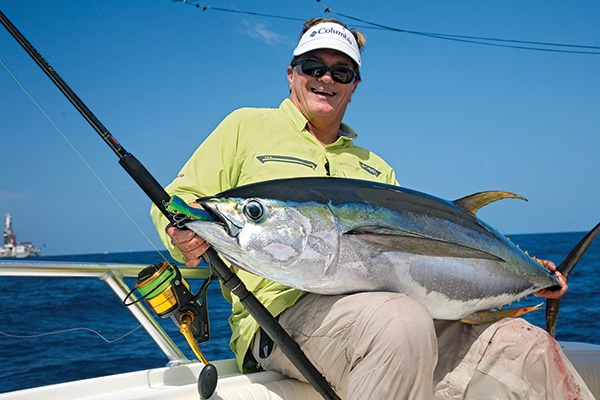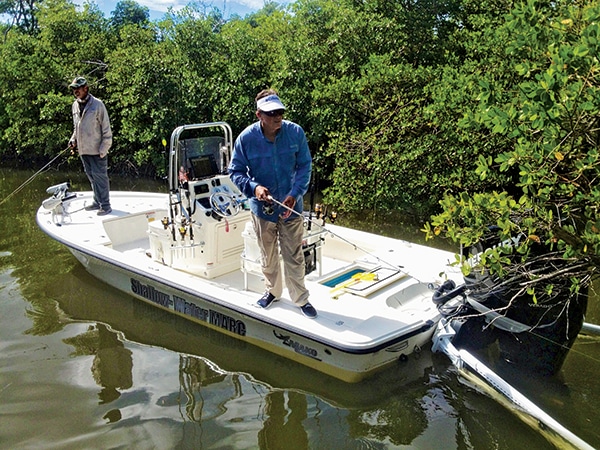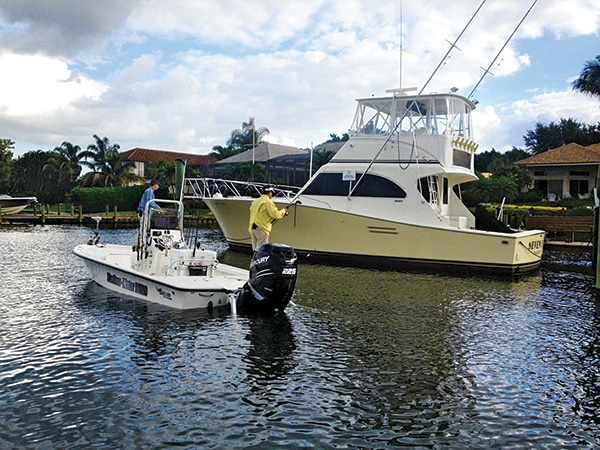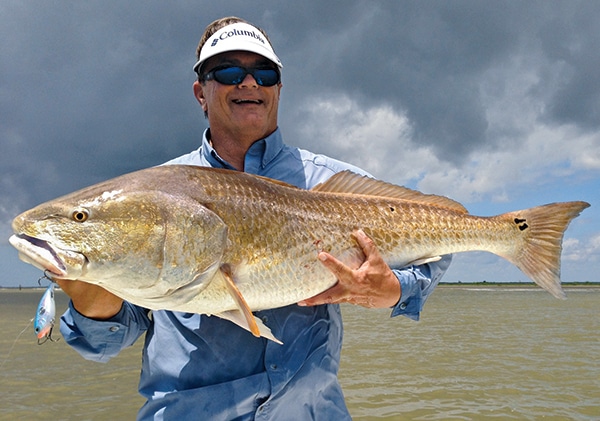
Capt. Tony DelosSantos and I Power-Poled down in a narrow Florida Keys backcountry creek where a smaller feeder stream intersected. The landscape comprised stately mangroves, and naturally, redfish were tight to the bank underneath the timber.
To catch these fish, Tony and I made low-trajectory casts, keeping the line close to and parallel with the water to avoid snagging the overgrowth. We’d halt the baits slightly up-current of the structure, let the line sink, then semi-free-spool them underneath. It worked like a charm.
“Side-arming” is the polar opposite of what we all grew up mastering: precision casting, where you take aim with your rod tip, followed by a swift and accurate forward pitch. When inshore fishing, side-arming often raises eyebrows and doubts on one’s experience. Yet, like the above scenario, sometimes it’s the only way to achieve accuracy with limited overhead space, which includes pitching under docks and parallel to bridge pilings. Side-arming is also a useful offshore tactic. More on this aspect later.

Accuracy Begins at Home
To maximize casting accuracy, fill your reels to capacity. This ensures distance, as opposed to spools with less line. Fresh line is a major advantage too, as its slick finish reduces friction and promotes longer and smoother casts. Compact knots — such as my favorite, the Bristol knot — are critical for joining line to leaders because that lure or bait must be reeled to within inches of the rod tip for maximum casting accuracy; knots must slip effortlessly through rod guides and bail rollers. Match rods to the appropriate reels and fill them with the respective line class. Slightly longer rods, if the situation permits, allow greater distance and accuracy. For example, my inshore rods range from 7-footers to those 71/2 feet in length; that extra half-foot — combined with their fast to extra-fast actions — greatly increases casting distances.

Outside Influences
The foundation for accurate casting, as mentioned earlier, requires the reel-seat portion of the rod to be raised up near the angler’s face, and then tilted so the tip can be aimed at the target. To initiate the cast, the rod should be raised to vertical, or sometimes slightly beyond, and then brought forward sharply, to be stopped when the tip is once again pointing at the target.
Casting in calm conditions requires very little (if any) stroke compensation. However, strong winds and currents make it necessary to adjust the cast in order to accurately deliver a lure or bait to its mark. Like geometry, precision now becomes a game of angles. For example, if a fish is holding on a point, or you wish to bait a specific piling, consider the direction of the wind, and how the current will affect your presentation. Attempt to position yourself so the wind is at your back. However, if you cannot get a downwind shot and are faced with a crosswind, determine how far upwind and at what angle you’ll need to cast the lure or bait to let the breeze accurately deliver your cast to the target.
Speed is essential in overpowering the wind, hence sharp and rapid casts. In addition, after the cast, immediately sink the line by lowering the rod tip to the water; this prevents the wind from catching the line and pulling the lure or bait away from the intended spot, or rapidly sweeping it through the zone.
Use the current to your advantage, and let it help take the lure or bait to the mark. I rely on current often, especially for drifting live baits underneath overhanging brush and docks. Again, compensate for the current, and then determine where the bait needs to go initially, prior to the cast. After the pitch, I’ll stick nearly half my rod underwater to sink the line deep enough to avoid snagging any overhanging branches.

Offshore Casting
One would think casting in a wide-open ocean is a cinch. Yet that’s not often the case, as outriggers, T-tops, fly bridges and extra fishing rods become seagoing, above-water obstructions. Aboard my center console, traditional casting is accomplished from the bow. However, from the console back into the cockpit, side-arming is necessary to avoid snagging the outriggers.
Side-arming requires the rod to be held at a 90-degree angle, much like you’d swing a baseball bat. Keep the rod even with the side of your body, or slightly beyond it for power casting, and then pitch out the bait with the same speed and quickness associated with a traditional cast. Like inshore targets, define where you want the bait to land, and compensate for any wind; a plus of offshore casting is that the boat can be positioned to keep the wind to your back to help with the cast. Also, whenever possible, try to keep the sun to your back — doing so helps illuminate the casting field.
With feeding fish — such as when tuna rise for a brief blitz — place the bait in front of and slightly off to the side of their snouts, not on the sides of the school or behind them. Retrieve your bait so it looks like the ones they’re eating and it’s either escaping (artificials, like poppers) or injured (fresh natural bait, like squid, flyingfish or ballyhoo). For white marlin on a teaser, or tailing sailfish, pitch a bait a few feet in front of the fish, and swim it off to the side of their bill so it comes into plain view.
Side-arming requires practice to become precise, but it’s a tactic that’s definitely worth the effort. Best of all, when it’s time to come tight and set the hook, the reverse low-trajectory angle should ensure rock-solid hook-sets.









